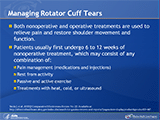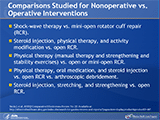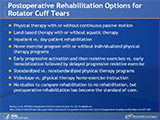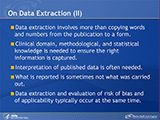- Home
- Slides
- Home
- Tools and Resources
- Research Summaries for Consumers, Clinicians, and Policymakers
- Search for Research Summaries, Reviews, and Reports
- Research Available for Comment
- Submit a Suggestion for Research
- Submit Scientific Information Packets
- Comparative Effectiveness Research Grant and ARRA Awards
- News and Announcements
- What Is Comparative Effectiveness Research
- Who Is Involved in the Effective Health Care Program
- What Is the Effective Health Care Program
Slides
Slides: 1–12 of 55
Background: Nonopioid Analgesics for Osteoarthritis
Presentation: Analgesics for Osteoarthritis—An Update
Keywords: analgesics | osteoarthritis | background
Background: Treatment
Managing Rotator Cuff Tears
Early vs. Late Surgical Intervention for Rotator Cuff Tears
Comparisons Studied for Nonoperative vs. Operative Interventions
Postoperative Rehabilitation Options for Rotator Cuff Tears
What to Discuss With Your Patients
Presentation: Comparing Medications for Adults With Type 2 Diabetes
Keywords: patients | shared decisionmaking | goals | adherence | reporting adverse events
On Data Extraction (II)
Presentation: Data Extraction
Keywords: data extraction | observational studies | risk of bias | applicability
Background: Treatment of Obstructive Sleep Apnea (2 of 2)
Other Outcomes of Interest (1 of 2)
Keywords: outcome | strength of evidence | compliance | questionnaire | mandibular advancement device | MAD | continuous positive airway pressure | CPAP | apnea-hypopnea index | AHI | surgery | treatment | oral device
Other Outcomes of Interest (2 of 2)
Keywords: outcome | strength of evidence | compliance | questionnaire | mandibular advancement device | MAD | continuous positive airway pressure | CPAP | apnea-hypopnea index | AHI | surgery | treatment | oral device
What To Discuss With Your Patients and Their Caregivers
Presentation: Drug Therapy for Rheumatoid Arthritis in Adults
Keywords: rheumatoid arthritis | RA | DMARDs | disease-modifying | antirheumatic | anti-rheumatic | rheumatic | biologic DMARD | withdrawal | adverse events | adverse effects | certolizumab pegol | etanercept | rituximab | anakinra | infliximab
Your slide tray is being processed.


 E-mail Updates
E-mail Updates










